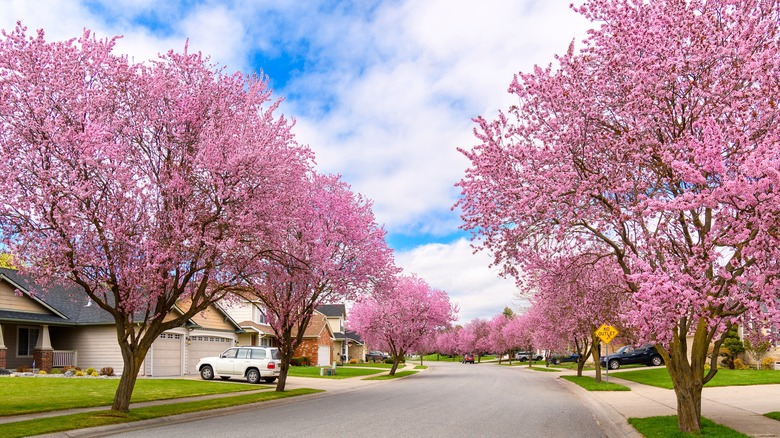Why You Should Reconsider Planting A Dogwood Tree In Your Yard
Dogwoods are often the first trees to bloom in the spring, and they don't hold back. These plants' showy pink or white flowers can attract cardinals to your yard and feed hungry butterflies. Unfortunately, many varieties — especially the flowering dogwood (Cornus florida) — are targeted by problem-causing insects such as borers. Tapping a dogwood trunk with a lawnmower is enough to cause an infestation. Dogwoods are especially prone to pests when their health is already suffering from leaf spot, twig blight, canker, or a fatal ailment such as dogwood anthracnose. Vulnerabilities like these make dogwoods hard to keep alive, plus they're fussy about sunlight and water.
If a dogwood tree receives too much or too little water, it experiences stress. This opens the floodgates to bacterial and fungal diseases. Determining how much water the tree wants can be tricky. Excess leads to yellowing leaves and rotting roots, while a dearth can make leaves turn brown and fall off. Aiming for consistent dampness is helpful, but downpours, droughts, and other impossible-to-control weather events can upend even the best-laid plans. Plus, dogwoods dislike weighty soil, which dries slowly after receiving too much water.
Dogwood trees may also show signs of dying in an overabundance of direct sunlight. Planting them in super-shady spots won't help. Instead, it's likely to hinder the trees' flowering process and make them grow even slower than they already do. Some gardeners find dogwoods frustrating because they grow at a snail-like pace of a foot per year. This problem is made worse by less-than-ideal soil. To avoid dogwood's pitfalls, plant a flowering species that's more resilient.
Beautiful and easy-to-maintain dogwood alternatives
Since dogwood care is so challenging, consider planting other trees that look similar but require less maintenance. Aim for trees that are native to where you live and suitable for your property's growing conditions. Several species are likely to check both of these boxes and provide bundles of beautiful blossoms.
Like dogwoods, magnolia trees don gorgeous petals in the spring. Their flowers, which are often pink or white, sometimes reappear in the summer and fall. Many magnolia cultivars tolerate clay and other heavy materials in the soil, and they tend to grow quickly, making them easy to establish in your landscape within a few years. Plus, there are eight types that are native to North America. Winter King hawthorn trees (Crataegus viridis 'Winter King') can also handle imperfect soil, as well as drought and pollution. In addition to offering pretty white flowers in the springtime, these trees boast glossy red berries that feed birds in the winter. They're native throughout much of the southeastern and midwestern United States.
Serviceberry trees, sometimes called juneberries or saskatoons, offer snowy white flowers in the early spring, plus red-orange autumn leaves and fruit that may draw cedar waxwings and other songbirds to your yard and garden. You can also enjoy the nutritious berries, which are delicious fresh, dried, or baked into muffins. Best of all, these rose relatives are forgiving, persisting when faced with alkaline soil, salt from icy streets, and inconsistent watering. Since nearly 30 serviceberry species are North American natives, you have plenty of choices. Popular cultivars include Regent (Amelanchier alnifolia 'Regent') and Autumn Brilliance (Amelanchier x grandiflora 'Autumn Brilliance').

